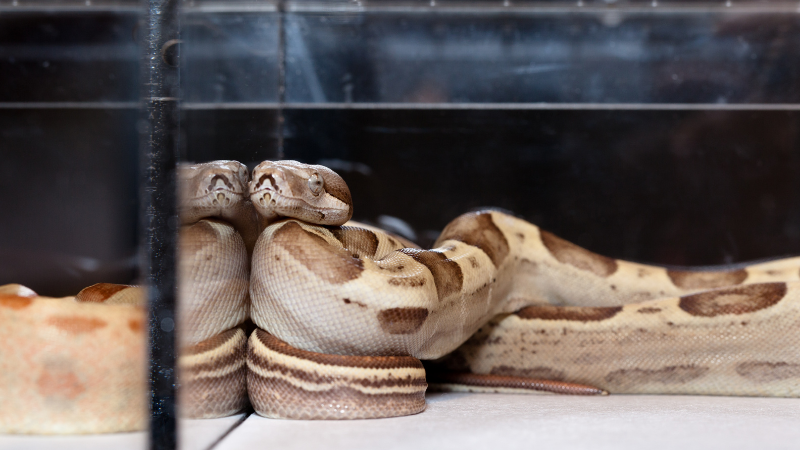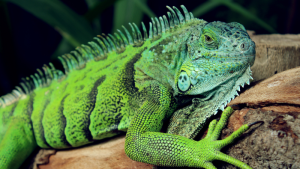As a reptile enthusiast, you get used to hearing cruel and unsavory things said about your pets on the daily. (“The only good snake is a dead snake.” “That would make a pretty pair of boots.” “I’d kill that thing if it came towards me.” etc.) It’s never fun to hear these things about your pets, but reptiles have been vilified by the media and horror films for so long, that people seem to think they don’t deserve the same grace we give to the fuzzy pets like cats and dogs.
Because of how deep this media bias goes it seems that people are now programmed to believe that every unsavory thing they hear about snakes and reptiles is true. Therefore, you also hear a lot of myths and misconceptions that are often quite baffling. One of the most widespread and completely false stories goes a little something like this:
“Once upon a time my cousin’s boyfriend’s sister’s friend had a snake, about 7 or 8 feet long. She loved that snake. They hung out together all the time. Then one day her snake stopped eating. This went on for months, and she was so worried she decided to take it in to the vet. The vet told her she was so lucky to bring her snake in and asked her if the snake had been sleeping by her fully stretch out. When she said it had been, the vet told her that the snake had been measuring her to make sure he could eat her all and starving itself so that it would have room to eat her. Isn’t that terrifying?”
If this story sounds at all familiar to you, you’re a victim out an urban legend being mistakenly remembered as fact then spread across the world. Let’s talk about a few reasons why this story is absolutely ridiculous.
Want to debunk more snake facts? Learn why reptiles don’t belong in plastic containers.
1. The Snake is Way Too Small to Eat a Full-Sized Human.
A seven-foot snake is no where near big enough to eat a full grown human. Neither is an eight-foot snake. Or a ten-foot snake. A twenty-foot snake is getting closer, but really you would need an over 20-foot snake before most full grown humans would really be in danger. That’s because the length of a snake is in no way a measurement of how much food they can eat.
The girth is what actually matters. Snakes can safely eat something that is about twice as wide as them. In captivity, we typically feed closer to the similar girth of the snake or 1.5 times it’s girth. A snake could potentially eat something even wider, but it runs the risk of bursting its own stomach or having to spit out the meal when it realizes it won’t fit, which isn’t great for the snake. Also, a snake that totally gorges itself on a prey item that’s too large will have a very hard time moving and hiding, which is not something a snake wants, especially in the wild.
Humans are also not great snake food because our shoulders are quite wide and would be hard for a snake to work it’s way around. Most animals that snakes eat have slight tapers and are a similar width the whole way down so that the snake is able to gradually work it’s way down the animal.
Finally, most reptile owners do not have over 20-foot long snakes. An eight-foot or ten-foot snake is considered huge by most reptile keepers. So odds are, the people you know who have pet snakes do not have the 30-foot long pet required for them to actually be in danger of being eaten.
2. Snakes are Opportunistic Eaters.
Snakes are opportunistic, ambush hunters. They eat when they’re hungry and able. A hungry snake will not, ever, pass up a good meal in hopes that they can eat something bigger later. Let’s just apply this story to a snake hunting in the wild to see how ridiculous it sounds:
Once upon a time there was a very hungry snake. It was surrounded by bunnies that would literally throw themselves at the snake in hopes of being eaten, but the snake didn’t want to eat any of those. No, this snake had just made it to seven-feet long and he wanted to eat a big animal to celebrate. That day a nice big deer came by. The deer took a nap in the field. While the deer was napping, the snake slithered over and layed out fully along the deer. ‘Soon . . .’ the snake thought, ‘I will be big enough to eat this deer. I just have to wait a few months to make sure my food, that usually only takes like a week max to digest, is fully digested so that I can fit this entire deer in. I hope it won’t wander away during the next few months so that it’ll still be here to eat when I’m finally ready.’ The deer moved on. The snake starved to death since it was stupid. The end.
Do you see how ridiculous that sounds? Snakes have varying hunting methods depending on the species, but the one thing they have in common is that they’ll never pass up a good meal. A hungry snake will eat at the first opportunity.
True, some snakes do go on hunger strikes, but it’s not because they’re waiting for something better to come along. It’s usually either related to seasonal changes or illness or getting older and needing less food. It is not ever related to a snake wanting to eat its owner.
3. Snakes Do Not Take Months or Even Weeks to Digest Their Food.
I touched on this briefly above, but snakes do not need to wait months for their food to digest so that they can eat again. Small snakes take about 3 or 4 days to finish digesting their food. Larger snakes can take around ten days to two weeks max to finish digesting a very large meal. There is no snake that needs months to digest a meal. Snakes can go a long time between meals because once they’ve digested a meal their slow metabolisms mean that they won’t use the energy quickly, but that doesn’t mean their stomach is full the whole time. If a snake is hungry and wants to eat, it could eat quite soon after its previous meal.
4. A Snake Owner Regularly Sleeping with her Snake?
This would be highly irresponsible behavior and despite what the world wants you to believe, most reptile owners are responsible. When one isn’t, it makes the news and you hear about it all over the world, but just because one bad snake owner makes the news doesn’t mean we’re all bad.
Snakes should be locked up in a safe and secure cages when you are not able to actively keep track of them. Not only would an owner risk rolling over onto the snake and injuring it or letting the snake get too cold, but the snake could very easily escape and get hurt while the owner’s asleep. Are there some irresponsible owners out there? Yes. But the overwhelmingly majority are responsible and are not going to let any of their snakes, especially their large snakes, free roam.
Snakes also don’t cuddle. If you were to wake up and a snake was next to you, that would mean that there was not a single other good source of heat available to the snake so they were drawn to your for your body heat.
In Conclusion:
I hope that this explanation has helped you understand why one of the most widely spread myths about snakes is not at all true and that the next time someone tries to tell you this story you’ll share what you’ve learned here.



